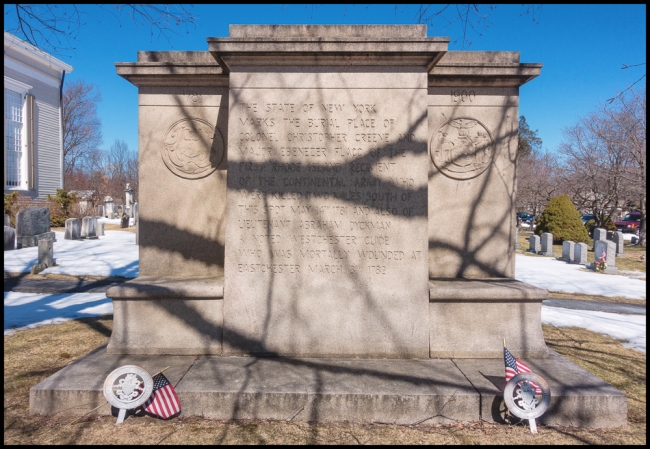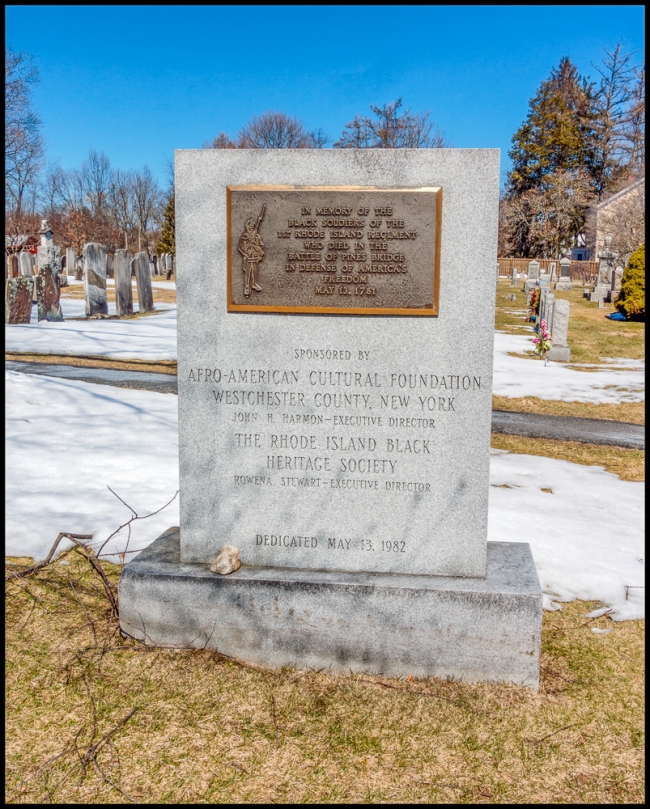When we first moved to the Hudson Valley in 1998 I noticed that one of the nearby towns was called Yorktown and I mistakenly thought that this was the famous Yorktown where the battle took place that ended the Revolutionary War. Just shows how little I knew about the Revolutionary War at that time. As my knowledge increased I quickly realized that the famous Battle of Yorktown took place in Virginia and not in New York.
I was therefore intrigued to discover these two memorials when I was wandering around the First Presbyterian Church of Yorktown the other day.
The first (above) reads:
The state of New York marks the burial place of Colonel Christopher Greene and Major Ebenezer Flagg of the First Rhode Island Regiment of the Continental Army who were killed two miles south of this spot May 1th 1781 and also of Lieutenant Abraham Dyckman A noted Westchester guide who was mortally wounded at Eastchester March 3rd 1782.
The second (below) reads:
In Memory of the black soldiers of the 1st Rhode Island Regiment who died in the Battle of Pines Bridge in defense of America’s Freedom May 13, 1781.
It seems that there was a Revolutionary War battle in Yorktown after all.
Looking a bit further I came across this interesting piece by Michael J. Kahn on the First Presbyterian Church of Yorktown’s website: The Battle of Yorktown…New York, not Virginia
Many have forgotten Westchester County’s role in the American Revolution.For instance, the Battle of White Plains: It was a major battle in 1776, as well as a major strategic defeat for the Patriots.
Most textbooks and classrooms neglect this battle for the clichéd fables of Lexington, Concord and Bunker Hill, to name a few. When most think of Yorktown, they envision the end of the war on a tiny peninsula on the eastern Virginia coast in October 1781. Contrary to this belief, the war did not end there, but continued for another two years until the Treaty of Paris.
The “other Yorktown,” in New York, did not officially exist yet as the Town of Yorktown was not yet incorporated. The area was composed of hamlets and villages, which for the purposes of our story consisted of Pines Bridge, Crotonville, Crompond and Croton Heights.
Nonetheless, the Battle of White Plains was an insignificant-significant battle. I say insignificant, in part, because the numbers of killed and captured there were far surpassed by many other engagements during the war. What made it significant was that the soldiers who comprised the 1st Rhode Island Regiment, an integrated unit, included free, or freed, blacks and Indians.
The 1st Rhode Island Regiment was quartered both inside the Davenport House (located on what is now Croton Heights Road) and outside around it in tents, as well as at neighboring farmhouses closer to the PinesBridge. The Davenport House also doubled as a command post under the direct orders of Gen. George Washington because the house overlooked Pines Bridge and the Croton River Valley.
Pines Bridge was a unique area for crossing the Croton River, as it wasthe only bridge over the river throughout most of the war. The Croton River was also a vital, natural barrier protecting this area from lower Westchester County.
Needless to say, guarding its crossing was of the utmost importance.Westchester County, itself, was a nightmare from a defensive point of view: It was nearly impossible to defend due to its geographical size, the Continental Army’s lack of manpower and its farming communities were constantly subjected to raids.
A little known fact to our generation, as well as generations past, is that the Bronx was part of Westchester during this period of history.The British soldiers of our story were garrisoned in the Morrisania section of the Bronx. The entire stretch of land between the Croton and Morrisania was nefariously referred to as the “neutral zone, a Godforsaken region to the average God-fearing person, a no-man’s land where the underprivileged inhabitants were frequently raided by robbers from both sides of the war.
The two main antagonists of this story are Lt. Colonel James De Lancey, of His Majesty’s Army, and Lt. Colonel Christopher Greene, of the Continental Army. De Lancey was in charge of a regiment known as the refugees—American-born volunteers, also known as Loyalists.
At the outbreak of the war, about a third of the colonists stayed loyal to England, a situation that made the revolution a civil war as well. These refugees engaged in a war of attrition against their fellow colonists, a style of warfare known as both total and unlimited war.This combat methodology does not discriminate between combatants and noncombatants. It targets civilians and their respective dwellings, businesses and infrastructures. De Lancey, and the men under his command, were probably the most notorious British military presence in Westchester. These same refugees earned the nickname of cowboys for their frequent cattle raids in the county.
Greene, on the other hand, died a hero’s death while fulfilling an officer’s duty. He was a distant cousin of General Nathaniel Greene, who would go on to be commander-in-chief of the Southern Army. Greene was charged with protecting the Pines Bridge crossing. Greene was also personally ordered by Washington to take De Lancey into custody, a mission not unknown to De Lancey. What was not known to Greene, however, was that De Lancey intended to turn his predator into the prey. During the morning of May 14, 1781, De Lancey led a surprise attack on Greene.
Each night the rebel troops stationed at Pines Bridge would remove the bridge’s floor planks as a strategic precaution to halt an enemy’s advance over the river. A guard was left on duty until daylight, when an enemy was least likely to risk a foolish attempt to ford the flooding river, or so the Patriots thought.
Greene possibly underestimated his opponent’s tenacity and assumed that no one would attempt a daylight crossing, especially by fording the river, given how high the water level was. De Lancey did ford the Croton at the Oblenis Ford, but only two-thirds of his troops made their way over.
To add insult to injury, the Continental Army troops stationed on the north side of the bridge left their post for breakfast. Loyalist guides, who knew every rock, tree and ditch, aided De Lancey’s troops. They were able to avoid every Patriot patrol from the river’s edge to the Davenport. As was the case in most of the battles, our generals (or lieutenant colonel, in this case) were more often than not, out-generaled, an observation made famous by John Adams prior to this event.
There were mitigating circumstances that may make me sound like an apologist for Greene. As previously mentioned, manpower was an ongoing crisis. Another enemy frequently struck down the soldiers who were ready and willing to take up the musket and sword: Smallpox. Had scores of men not been bedridden with this epidemic, more men may have been stationed from the river’s edge up to Davenport’s and a better chain of communication may have been maintained, turning the odds into evens.
Triumph, not tragedy, may have been the end result.
The attack happened after sunrise. All archaeological evidence testifies to a westerly advance, including the musket ball holes in the west side of the house. The Patriots were only able to fire a few shots before being overrun. Greene was shot and stabbed several times before he was taken prisoner. In the end, the battle was over before it really ever began. Greene was thrown on a horse and was either discarded, or fell off the horse, and left to die. Regardless, none of the present enemies made any attempt to help or care for him properly as a prisoner of war. Two Continental Army officers discovered his body the next day. According to the late historian Allison Albee, the Patriots suffered 10 dead, 1 seriously wounded and 23 captured. The black soldiers who were caught were later sold into slavery in the British West Indies.
De Lancey and his band of refugees returned to New York City, or York Island as it was then known. De Lancey’s attack and subsequent return to New York added more fuel to the burning fire of hatred in Washington’s heart; he wanted De Lancey arrested and New York retaken from the British. Unfortunately, Washington would never achieve either goal: De Lancey evaded capture throughout the entire war and New York would remain an impregnable British fortress until after the Treaty of Paris was signed in 1783.
Today, the monuments at the First Presbyterian Church, located at 2880 Crompond Road, are some of the very few testaments to the sacrifices of Greene and his troops. The British burned the original church that stood there in 1779, which was being used as a headquarters for the Continental Army. Greene, along with other Continental officers and soldiers, is buried in the church’s cemetery. With the exception of the musket ball holes still in the side of the Davenport House, there is little to show where our Yorktown made its mark in the history of our nation’s birth.
The old Pines Bridge is, I’m told, slightly visible whenever the area suffers a drought. Invisible, however, are any indications of its importance from an era so long ago. There are no landmark signs on the Crow Hill entrenchments (or redoubts as they are also known), which were defensive trenches dug into the ground by the Continentals following the Battle of White Plains in 1776. Washington ordered Gen.Reazin Beall and his Maryland regiments to construct these fortifications to protect the Croton Valley and to guard the critical Pines Bridge crossing below.
This place may not have been Morristown or Valley Forge, but nonetheless, American soldiers spent many a night here, freezing and bearing the intolerable heat of the summer days while manning their posts. Basically, all we Yorktowners have is an oral history. Hopefully, this will one day change.
As was the case with many of the battles of the Revolution, Pines Bridge was a defeat for our side. However, we obviously ended up the victors in a war that lasted eight tumultuous years. The real tragedy would be to forget these brave men, their times and their sacrifices.
So more of skirmish that what I think of as a battle, but a fascinating piece of history nonetheless.
Taken with a Sony RX-100 M3.


